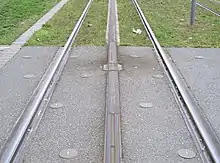Ground-level power supply
Ground-level power supply, also known as surface current collection or alimentation par le sol (which literally means "feeding via the ground"), is a concept and group of technologies whereby electric trams collect electric power at ground level instead of more common overhead lines. Ground-level power supply is, or has been, used primarily for aesthetic reasons.
.jpg.webp)

Ground-level power supply systems date back to the beginning of electric tramways, with some of the earliest such systems using conduit current collection. More recently, new systems such as the Alstom APS, Ansaldo Tramwave or Bombardier Primove, have been introduced which use modern technology to address some of the limitations and dangers of the older systems.
Systems
Conduit
Conduit current collection has the power supply carried in a channel under the roadway between the running rails, much in the same fashion as the cable for cable cars.
Stud contact
The stud contact systems was developed around 1900, and used by several tramway companies in Paris and in England. Associated with these systems were the inventors Dolter and Diatto. Power was supplied from studs, set in the road at intervals. Switching in of the contacts was done by strong electromagnets beneath each car. Each contact contained a fuse, which would be blown by an earthed safety shoe on the rear of the tram should the contact not have switched out. This proved to be unsatisfactory because the strong currents melted down the switch contacts, resulting in contacts frequently remaining 'live'.
Prague
In Prague, a ground-level power supply was applied at the experimental, recreational and promotional tram line operated by the Czech inventor and entrepreneur František Křižík at Letná hill. It was the first electrically-powered tram line in the Prague agglomeration. The track was operated between 1891–1900; however the ground-level power supply was tested there only in early 1896 on one part of the track. Power was supplied through a third rail but a system of contact relays ensured that voltage was there only when a car was directly above.[1]
In 1905, a similar system by František Křižík was used on the Charles Bridge. This section was the last one with horse-drawn trams, due to disapproval of overhead lines there. Ground-level supply made it possible to electrify this track. However, the weight of the trams caused damage to the bridge due to vibrations, which is why they were replaced by rail buses in 1908. These were stopped in 1909. In 1932–1939, classic buses on tyres were operated there. Since 1965, Charles Bridge has been a pedestrian-only zone.
Budapest
Another system of ground-level power supply was used by Budapest trams from 1887. Overhead lines were considered an eyesore, so builder Siemens developed the following system: on the inner side of one rail, a powered third rail was hidden underground in a half-covered ditch, with a narrow slit opening upwards, through which a trolley pole reached downward from the trams. The Budapest system was generally safe and water-protected. However, there was no defence against snow and ice, dirt filled up the ditches and trolley poles suffered intense wear. Overhead wire replaced the "Budapest system" everywhere by the 1920s.
Stream system
Stream is an acronym that stood for "Sistema di TRasporto Elettrico ad Attrazione Magnetica" ("System of Electric Transport by Magnetic Attraction"). The channel made of composite material was thus insulating the vehicle equipped with a special shoe on the passing magnetic channel raised the band allowing contact with the copper strip and then the electrical connection.
Alstom APS
APS uses a third rail placed between the running rails, divided electrically into 11-metre segments. These segments automatically switch on and off according to whether a tram is passing over them, thereby eradicating any risk to other road users.APS was developed by Innorail, a subsidiary of Spie Enertrans but was sold to Alstom when Spie was acquired by Amec. It was originally created for the Bordeaux tramway, which was constructed from 2000 and opened in 2003. From 2011, the technology has been used in a number of other cities around the world.[2][3]
Ansaldo Tramwave
In 2017, another ground-level power supply technology, TramWave, developed by Italian company Ansaldo Energia, successfully entered commercial application via the opening of Zhuhai tram Line 1 first phase in China, and it is said to be the first 100% low-floor tram system adopting ground level power supply technology.[4] Later in the year, Western Suburb Line in Beijing will also be opened with the same technology from Ansaldo.[5] The technology have been licensed to CRRC Dalian and all the technologies were transferred to China.[6]
See also
References
- František Křižik's Canadian patent 53468
- "Third-rail trams across the Garonne". Railway Gazette International. 2004-02-01. Retrieved 2008-05-02.
- "APS: Service-proven catenary-free tramway operations". Alstom. Archived from the original on 2020-11-29. Retrieved 2020-11-29.
- 历经磨难 全球首个地面供电的100%低地板现代有轨电车项目终成正果
- 去颐和园、香山更方便啦!西郊线年底运营,还能和地铁换乘
- 中国首次引进现代有轨电车技术(图)
External links
| Wikimedia Commons has media related to Ground-level power supply. |